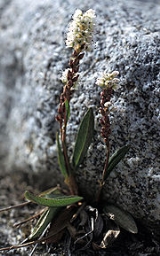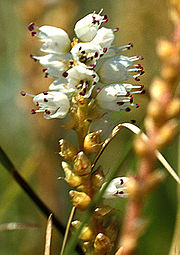
Alpine Bistort
Encyclopedia
Polygonum viviparum commonly known as Alpine Bistort, is common all over the high Arctic. It stretches further south in high mountainous areas like the Alps
, Carpathians
, Pyrenees
, Caucasus
and the Tibetan Plateau
.
 It grows to 5-15 cm tall with a thick rootstock. The basal leaves
It grows to 5-15 cm tall with a thick rootstock. The basal leaves
are longish-elliptical with long stalks; upper ones are linear and stalkless. The flower
s are white or pink in the upper part of the spike; lower ones are replaced by bulbils. Flowers rarely produce viable seeds and reproduction is normally by the bulbils. Very often a small leaf develops when the bulbil is still attached to the mother plant. The bulbils are rich in starch and are a preferred food for Rock Ptarmigan and Reindeer
; they are also occasionally used by Arctic people.
Alpine Bistort grows in many different plant communities, very often in abundance.
As with many other alpine plants, Alpine Bistort is slow growing, with an individual leaf or inflorescence
taking 3-4 years to reach maturity from the time it is formed.
Alps
The Alps is one of the great mountain range systems of Europe, stretching from Austria and Slovenia in the east through Italy, Switzerland, Liechtenstein and Germany to France in the west....
, Carpathians
Carpathian Mountains
The Carpathian Mountains or Carpathians are a range of mountains forming an arc roughly long across Central and Eastern Europe, making them the second-longest mountain range in Europe...
, Pyrenees
Pyrenees
The Pyrenees is a range of mountains in southwest Europe that forms a natural border between France and Spain...
, Caucasus
Caucasus
The Caucasus, also Caucas or Caucasia , is a geopolitical region at the border of Europe and Asia, and situated between the Black and the Caspian sea...
and the Tibetan Plateau
Tibetan Plateau
The Tibetan Plateau , also known as the Qinghai–Tibetan Plateau is a vast, elevated plateau in Central Asia covering most of the Tibet Autonomous Region and Qinghai, in addition to smaller portions of western Sichuan, southwestern Gansu, and northern Yunnan in Western China and Ladakh in...
.

Leaf
A leaf is an organ of a vascular plant, as defined in botanical terms, and in particular in plant morphology. Foliage is a mass noun that refers to leaves as a feature of plants....
are longish-elliptical with long stalks; upper ones are linear and stalkless. The flower
Flower
A flower, sometimes known as a bloom or blossom, is the reproductive structure found in flowering plants . The biological function of a flower is to effect reproduction, usually by providing a mechanism for the union of sperm with eggs...
s are white or pink in the upper part of the spike; lower ones are replaced by bulbils. Flowers rarely produce viable seeds and reproduction is normally by the bulbils. Very often a small leaf develops when the bulbil is still attached to the mother plant. The bulbils are rich in starch and are a preferred food for Rock Ptarmigan and Reindeer
Reindeer
The reindeer , also known as the caribou in North America, is a deer from the Arctic and Subarctic, including both resident and migratory populations. While overall widespread and numerous, some of its subspecies are rare and one has already gone extinct.Reindeer vary considerably in color and size...
; they are also occasionally used by Arctic people.
Alpine Bistort grows in many different plant communities, very often in abundance.
As with many other alpine plants, Alpine Bistort is slow growing, with an individual leaf or inflorescence
Inflorescence
An inflorescence is a group or cluster of flowers arranged on a stem that is composed of a main branch or a complicated arrangement of branches. Strictly, it is the part of the shoot of seed plants where flowers are formed and which is accordingly modified...
taking 3-4 years to reach maturity from the time it is formed.

